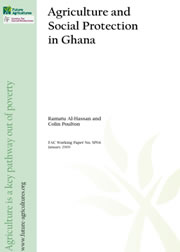By Ramatu Al-Hassan and Colin Poulton
January 2009

Ghana was one of the first countries in Africa to embark on structural adjustment reforms. 25 years on, its continuing commitment to reform for national economic development has yielded impressive gains in growth and poverty reduction. Poverty in the country is measured through periodic.
Ghana Living Standards Surveys (GLSS). In 1991/92 GLSS3 found that 51.7% of the population were living below the national poverty line. By 1998/99 (GLSS4) this had fallen to 39.5% and by 2005/06 (GLSS5) it had fallen to 28.5% (Ghana Statistical Service2007). In absolute terms the number of poor people in Ghana has fallen from 7.9 million in 1991/92 to 6.2 million in 2005/06. At current growth rates, Ghana should achieve MDG1before 2010. However, the fall in poverty has not been experienced equally around the country.
GLSS5 figures show poverty headcount rates in the five southern regions of the country of between12% (Greater Accra) and 20% (Ashanti, Central, Eastern, Western). These regions have all seen dramatic falls in poverty since 1991/92 due to urban growth, minerals extraction and,in the recent survey period, a boom in the cocoa sector in response to higher world prices and domestic market reforms and production support. The “transitional” regions, Brong Ahafo and Volta, have also witnessed impressive falls in poverty to around 30% in 2005/06. However, poverty in the three northern regions – Northern, Upper East and Upper West –remains stubbornly high at 52-88%.
In 2005/06 the three northern regions accounted for just under 22% of the population, but 45% of the headcount poor, 57% of the headcount extreme poor and 80% of extreme poverty severity1 in the country (Ghana Statistical Service 2007). The livelihood classification used by GLSS shows poverty to be concentrated amongst “foodcorp farmers”, who are encountered disproportionately (but not exclusively) within the three northern regions. This group accounted for 43% of the population in 2005/06, but 69% of the headcount poor. Whilst the poverty rate amongst “food crop farmers” (68%) and “export The P2 poverty measure using the lower (extreme poverty) line.
{jcomments off}
